There are many options for beautiful casual furniture, but once you find a set that matches your aesthetic, you will want to keep it nice for years. This article discusses how to clean and care for different types of outdoor frames and fabrics, and the usefulness of patio covers
Over time, the destructive power of the sun will fade almost anything: fabrics can fade quickly, and even metal and plastic fade over many years. Water can be annoying and can temporarily prevent use, but most high-end casual furniture is not damaged by water, and dries out quickly as long as the water isn't trapped anywhere.
A patio furniture piece almost always consists of a frame and a detachable cushion; lets discuss frames first
Frames
The frames of casual furniture are made from durable and weather resistant material, although some types need an additional level of care or consideration.
Aluminum is highly weather resistant and mobile, however it is a soft metal, so caution should be taken not to bang or scrape pieces together, as they will scratch. Metals are naturally sun resistant, and the more powder coats a piece has, the more sun resistant it gets. Aluminum can be left out all year and never rust or breakdown since moisture has little effect on it, although in extreme sunny environments it will fade as years pass.
Soap and hot water work well to clean aluminum furniture; if you use a brush, use one without metal bristles, as that can scratch the finish. Do not clean with acidic cleaner (such as a muriatic solution) as acid can corrode aluminum.
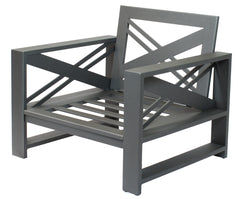
Resin Wicker pieces are made from polymer weave over on a metal skeleton. If the frame is aluminum, the whole piece will resist water damage and dry quickly. Resin wicker is made with UV inhibitors to slow down the process of sun fading: it will fade eventually but should hold it’s color for thousands of hours of sun exposure. Natural wicker (rarely used in high-end patio furniture anymore) fades more quickly.
Wicker can be cleaned with soap and water, or cleaned gently with bleach. Cleaning between the weave can be difficult, so if water and a rag isn’t doing the trick, consider removing the cushions and using a hose to get a high-pressure stream to get inside the grooves of the wicker.

Wood (Eucalyptus/Teak) is a hard material that resists physical damage well. Wood is a porous substance, so it can absorb moisture and get damaged over time; it can warp, get stained from spills, or rot. To clean Eucalyptus or Teak, use mild soap and water, a cloth, and let it dry out in the sun after it is rinsed off.
Using a wood sealer on wood patio furniture prevents water from getting into the wood, and gives the wood a finished polished look. If you reside in a dry climate that gets little rain (such as Arizona), you probably don’t need to seal more than once every few years. If you are in a wetter environment however (such as Western New York), you will likely want reseal your wooden furniture with wood sealer every year. Just make sure to clean furniture well first, and let it dry out completely as to not seal moisture inside of the wood. This additional consideration should keep your high-end wood furniture looking sharp for decades.
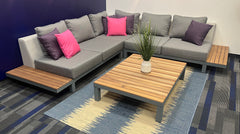
Marine Grade Polymer is often used in modern Adirondack designs, and is overall the most durable material. It is essentially a hard plastic, so it is moisture immune and sun resistant, and it is a physically tough material that can take a beating. Just like any material it will fade with enough hours in the sun, but it should be thousands of hours of UV exposure. This material is as close to you get as ‘set up and forget forever’.
Polymer can be cleaned with soap and water, bleach, or alcohol (for grease stains). If you use a brush, use one without metal bristles, as that can scratch the finish
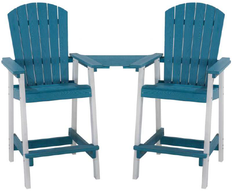
Stone furniture is often built in to your patio, and if cared for well will probably outlast us. It can be brittle in places, so just don’t drop a hard and heavy object onto one of the weaker spots and you should be good.
Stone doesn’t suffer from sun fading or rust, although stone can it can get stained and discolored over time. To clean stone furniture, wet the stone face, then scrub it clean with a brush. If there is staining that is persistent, it can be cleaned with a solution of muriatic acid (also known as hydrochloric acid)

Steel furniture is very strong, and will not rust IF it is powder coated and in perfect condition (the powder coat keeps moisture out of the actual metal). However, if it gets minor damage, it now has a weak point for where rust can get in and spread. If you have a steel set that has minor damage but is worth saving, clean it well and apply a metal sealer or rust inhibitor (like Rust-Oleum)
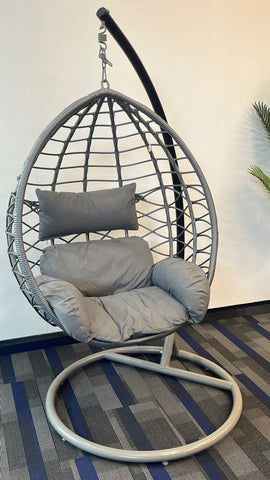
Wrought-Iron furniture is extremely tough and heavy, but will rust easily. It should usually be brought in in the winter to protect it from the damaging effects of moisture. You can clean it with water and mild soap or vinegar. If your wrought-iron piece is powder coated, it will be similar to steel: it can be left out, just take account of any damage it suffers, as damage creates a weak point where rust can build up.
Cushions
The fabric of outdoor cushions fade faster than furniture frames, even with top level performance fabric. Cushions made from solution dyed fabric (whether polyester, acrylic, or olefin), have good sun resistance, and should hold their color for 2-4 years depending on how sunny the climate is. Acrylic fabric (the fabric type of the famous Sunbrella brand) has a small UV resistance edge over polyester or olefin and will hold color for 3-6 years depending on climate.
If polyester cushions are made from spot-dyed fabric, get ready to replace cushions frequently, as they will fade from a few months of sun exposure so get ready to take them inside or cover them consistently. Any outdoor cushions can be cleaned with soap and water, however you can also lightly clean solution dyed fabrics with bleach, because the color is throughout the entire strand of the fabric. If you clean spot-dyed polyester with bleach you will simply pull all the color out.
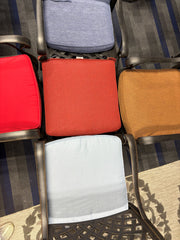
If there has been heavy rain and your cushions have taken on water, set the cushions up on their sides, with the zipper down if they have one to help cushion drain and dry out. High-density weave cushions (lots of threads per inch) do not take on water easily, so unless there is a very heavy rain or the cushion is sitting in pooled water, often leaving it alone in the sun for an hour or two is all that is needed.
When cushions have mold problems, it is usually because dirt has gotten into the cushion, not simply because the cushion got wet. If cushions get dirty, they should be cleaned with soap and water, or water and bleach.
Should you get a patio cover?
One option to protect your investment is to get a patio cover, which is primarily to protect against the sun, and dirt/debris. Because patio covers keep dirt out of cushions, they can help keep cushions clean and fresh over time. Patio covers will hasten a set's use after a rain, although high-end patio furniture and fabrics dry out quickly left on their own. For some people (such as myself), moving cushions on and off of patio furniture with every use is too time and energy consuming, but for those that have a set near grass and dirt, or want to keep their set pristine and unfaded for as long as possible, patio covers are a good option.

Leave a comment